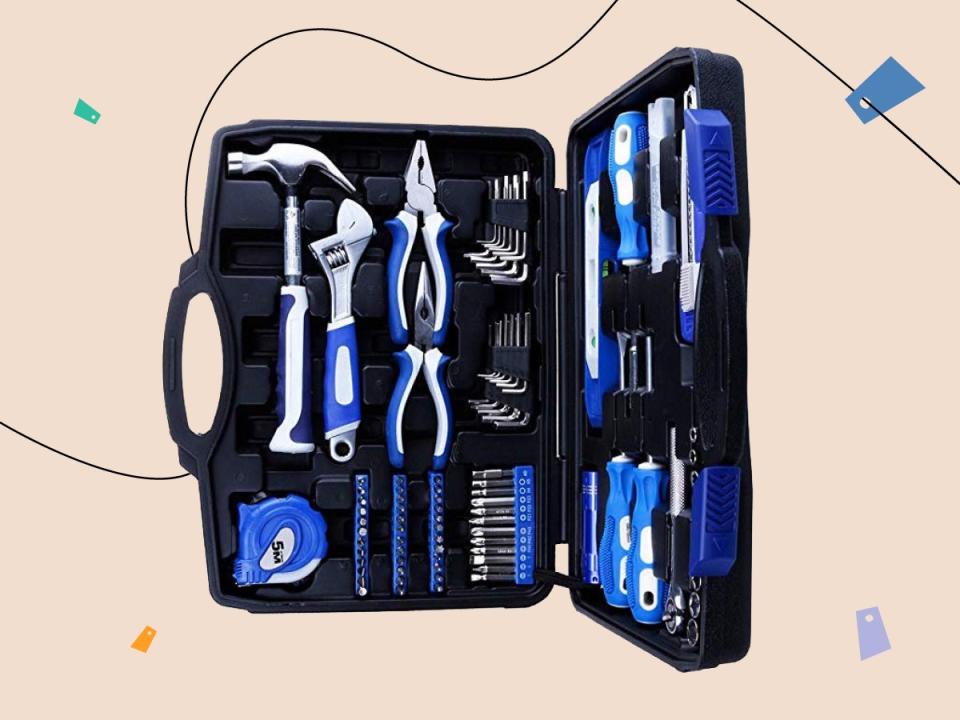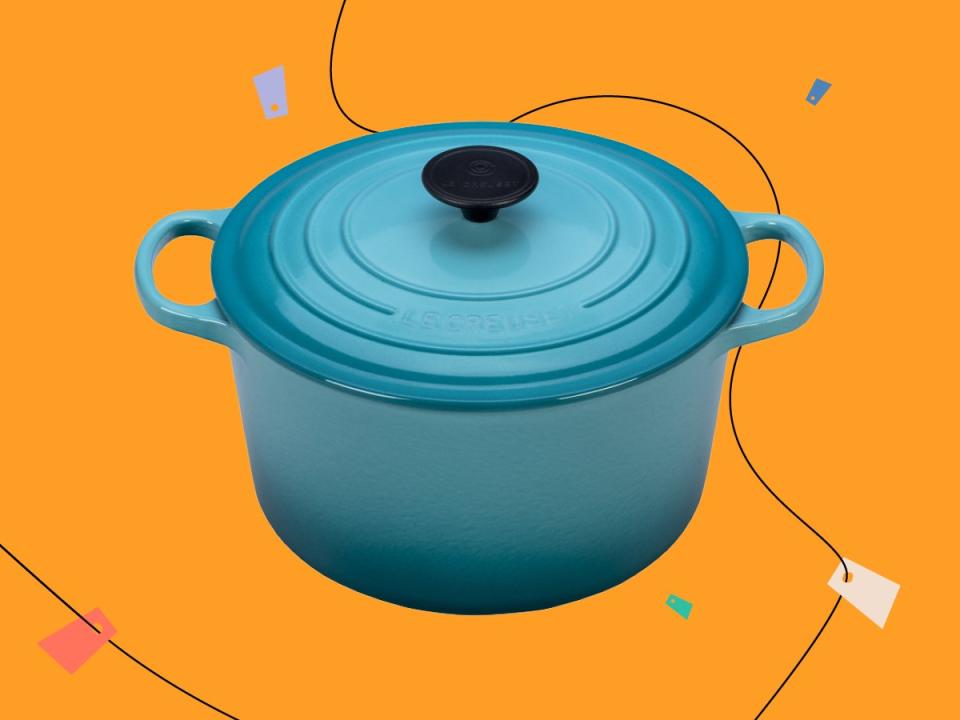The Divorce Registry Isn't a Thing, but It Should Be
One of the most stressful parts of the lead-up to getting married—and, trust me, there were a lot—was the pressure from my mother to keep adding to our wedding registry. Even though my (now ex) husband and I were living in about 1,000 square feet, she had her heart set on us having full sets of matching towels, monogrammed luggage, formal china, crystal, and entirely too much more. I pushed back on a massive registry. Somehow, I lost.
Even as I write this, I can look up and see a full set of crystal champagne glasses, gathering dust atop a shelf I can’t reach. Though the marriage is in the past, I’m still lugging them around, along with tons of other…stuff. (There’s got to be a metaphor in there somewhere, right?) It’s funny how a wedding is meant to symbolize the start of something new, but it often begins weighed down by old-fashioned things most of us don’t actually need.
Of course, the painful irony is that the time in life when friends and family giving you carte blanche at Bed, Bath & Beyond would be a godsend isn’t when you’re getting married—it’s when you’re getting divorced. After you walk down the aisle, you combine things in a way that’s more cost-effective: sharing rent, health insurance, a tax bill, a toaster. Divorce means dividing that shared life in two and, sometimes, starting from scratch solo if your partner takes a chunk of the household necessities (see aforementioned toaster) can get pricey fast.

It’s a subject that writer Sarah Bregel recently tackled in a wonderful essay for The Washington Post, and—given the lengthy comments section—it definitely struck a nerve. Including with me: When my ex moved out, we tried to split things up equally; it felt like the “right” thing to do. Unfortunately, that left me with a half-furnished apartment, half a set of dishes, and the old television. (Even now I’m a little mad I let him take the new TV I bought him as a gift right before things soured.) But asking friends and family to literally buy me things—the same way they did when I walked down the aisle—never even occurred to me as an option while getting divorced.
Bregel, the Post essayist, says she felt the same: “I certainly didn't expect anyone to give me anything when they found out my husband and I were parting ways—that's not our societal norm," she wrote to me via email. "But there really has been no greater time in my life when I've needed things and not had the means to acquire them,” she wrote to me via email.
Instead of selecting those fucking monogrammed towels, maybe this time around I’d register for a Cuisinart and a tool set, and my experiential picks would be some quality time in a pedicure chair.
Her essay, and our subsequent conversation, got me thinking about how much a divorce registry would have helped me during that tough time. It also made me wonder what other women would actually register for.
Was I alone in wanting to restock my kitchen, Izola-style, with a list I’d create and share with family and friends? Or would a Honeyfund-esque model be a better choice? Instead of selecting those fucking monogrammed towels, maybe this time around I’d register for a Cuisinart and a tool set, and my experiential picks would be some quality time in a pedicure chair. But when I started to ask other women what they’d actually put on their ideal divorce registry, it turns out they wanted more of a GoFundMe situation at this stage in their lives: According to my sources, the ideal divorce registry largely features straight-up cash.

“I was the one who left, and I ended up leaving a lot of things behind,” explains Lysa, who split with her ex-husband when she was 36. (All the women Glamour.com interviewed for this story asked to be identified by their first names only.) “In the process, I lost a lot of kitchen items, but I told myself at the time that ‘it's just stuff.’” But restocking her kitchen has been a very long process that is, several years later, ongoing. “What I didn't get then,” Lysa added, “was that all that ‘stuff’ actually costs money.”
Addie got married at 24 and divorced at 30; she and her ex coparent two children. She told me that figuring out their finances was difficult due to harsh economic realities, including an imbalance of who had more money even during the marriage. “The money in my accounts was mine. But so was the debt.” Which ultimately meant: She was cash-strapped and could have used a boost from family and friends.
She’s far from alone. With millennials careening into their thirties, more and more are feeling the strains of adult life and the impact these strains can have on a relationship. As the first generation whose circumstances are expected to not likely improve upon our parents’, who are living in an era of affordable housing crisis for whom the total outstanding student loan debt now stands at $1.52 trillion, we have a lot of money worries without the added stress of a divorce and starting over alone. But ending the marriage itself was a positive thing.
Amy, who married at 24 and divorced at 29, says that, after her split, it wasn’t things that needed replacing. “I didn't have any money in savings when we split up and ended up having to borrow from my parents to help me cover rent for a few months,” she said. For her, it was simply about paying for a place to live.
A divorce registry could alleviate some stress by allowing women to share what kind of help they need to get through a financially trying time. Maybe it’s help covering rent, the mortgage, car payments, or a gift card for the Internet bill.
That was also true for Addie. She shared that, because she and her ex had two children, getting a second apartment that accommodated everyone stretched her finances superthin. “It was the worst feeling in the world to know how tight money was, but the alternative”—staying—“was worse,” she said. She also related that it was those kinds of logistics that kept her from moving forward with a divorce for “far too long” in the first place.
But a divorce registry (which might be more culturally palatable under a different name, like an “I don’t fund" or maybe "singlehood stockpile") could alleviate some of that stress by allowing women to share what kind of help they need to get through a financially trying time. Maybe it’s help covering rent, the mortgage, car payments, or a gift card for the Internet bill.

Cash aside, though, there were items that women I spoke to admitted they might have registered for after splitting up, like replacements for the bedding and towel sets they lost in the divorce that help make a new living space into a functioning home.
Self-care products and appliances were on the lists, as were tools: Whether she's single or not, a power drill can be a girl’s best friend. Amanda, who divorced at 33, told us her dream divorce registry would have been filled with tools that her ex-husband used—“tools that I did not think I would need, because he did the ‘heavy lifting.’” A string trimmer and a lawn mower would both be on her list. “The day I felt my most independent,” she reflected, “was when I bought myself a garden tiller.”
Another category of divorce registry items were things that would make it easier to do the things you love again. For Lysa, that meant new cookware. “Anything that would allow [me to] host people for dinner. I tend to lose myself in cooking, so having that outlet would have been a real source of strength for me.” Amy, on the other hand, wanted the opposite after she moved into her own place, but still craved help to make something easier. “In the early days I ate way more takeout than normal because cooking felt like too much of a chore—a GrubHub gift card would have been awesome,” she says.

After talking to women who, like me, have a divorce in their past, I gave some thought to what I would have put on a divorce registry, had that been an option I could have turned to at the time: pedicures, takeout gift cards, and maybe a replacement juicer would have made the list. What I definitely didn’t need was a set of crystal champagne flutes.
But it turns out that sometimes they are nice to have. I use them exactly once a year: on New Year’s Eve, when I break them out to toast with my friends and my fiancé, whom I’m marrying this fall. And in case you’re wondering: We do have a registry—but this time we've registered for a little honeymoon help, a gift that will never gather dust on a high shelf.
After peaking during the 1970s and '80s, much has been made of the fact that divorce rates are now on the decline, especially among millennials. Still, if you’re thinking about splitting with your spouse, or you’ve already been through a divorce, sunny statistics aren’t exactly useful. Throughout this weeklong series, Glamour.com explores what it means to uncouple in a modern world.


